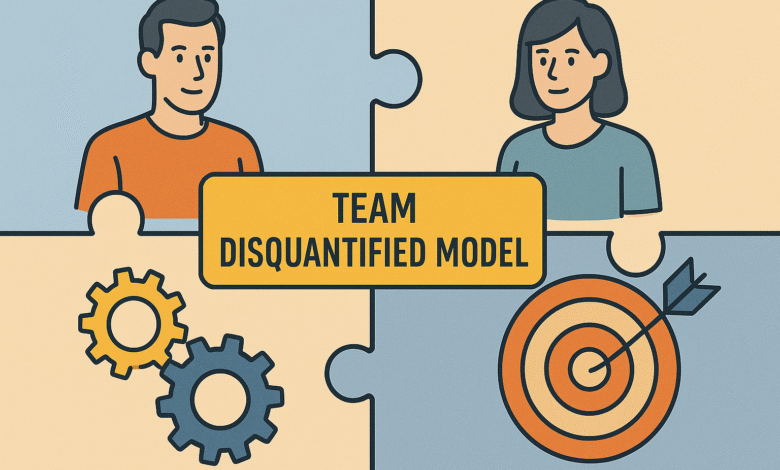Team Disquantified: A New Era of Workplace Collaboration

In today’s fast-changing professional world, businesses are constantly looking for better ways to build teams, improve efficiency, and achieve stronger results. One of the most innovative ideas gaining popularity is team disquantified. Though it might sound unfamiliar, this model offers a fresh and flexible approach to working together, moving away from strict roles and titles.
This article will explain what team disquantified means, how it started, why it’s important today, its main principles, the benefits and challenges, real-life examples, how to adopt this system, and how it compares to traditional team setups. By the end, you’ll see why many companies are turning to this model to prepare for the future of work.
What Is Team Disquantified?
The term team disquantified refers to a team setup where members are not restricted by specific job titles or traditional ranks. Instead, team members are selected based on their skills, adaptability, and the needs of the task at hand. This approach removes rigid structures like job grades or fixed responsibilities and treats each team member as a valuable, multi-talented contributor.
Rather than staying within department lines or strict hierarchies, a team disquantified model encourages flexible collaboration. People work where they are needed most, and their value is measured by the outcomes they help achieve, not by the titles they hold.
Where Did the Concept Come From?
The idea of team disquantified draws inspiration from modern work practices like agile methods, cross-functional teams, and human-centered design. These systems often allow roles to shift depending on the project and focus on progress through teamwork.
It also aligns with the ideas behind holacracy, a decentralized way of managing teams where authority is spread out rather than held by a few leaders. Many creative and tech companies began using this flexible team style in studios and innovation hubs. In such places, labels like “manager,” “developer,” or “designer” were often less important than getting results.
Why Is Team Disquantified Important Today?
Several major trends in today’s work environment have made team disquantified more relevant:
1. Rise of Remote and Hybrid Work
With more people working remotely, the traditional office setup doesn’t always apply. Team disquantified fits this change by supporting flexible and distributed work styles.
2. Need for Agility
Markets and technology evolve quickly. Teams must adapt fast, and a team disquantified model allows organizations to reorganize quickly and apply skills where needed.
3. Empowering Employees
Younger workers seek meaningful work, learning opportunities, and freedom. In team disquantified models, people are not stuck in narrow roles—they can explore new areas and grow professionally.
Key Principles of Team Disquantified
Here are the core ideas behind team disquantified:
– Skill-Based Teaming
Rather than being grouped by department, team members are chosen based on what skills a project needs. For example, a writer, a marketer, and a software engineer might work together on a product launch.
– Role Fluidity
Team members don’t hold one fixed role. Someone could lead one project and support another in a different way.
– Results-Focused Collaboration
Success is measured by what the team achieves, not how closely someone followed their job description.
– Rotating Leadership
Leadership can change depending on the situation. If someone has deep knowledge in a certain area, they may take the lead—even if they don’t hold a leadership title.
Benefits of a Team Disquantified Structure
Choosing a team disquantified approach can offer many advantages:
- More Flexibility: Teams can respond quickly to change or new opportunities.
- Better Use of Talent: People use their strengths, not just their job titles.
- Greater Engagement: Workers are more involved and motivated when they have variety and influence.
- Faster Innovation: Diverse skills and cross-functional thinking lead to more creative solutions.
- Less Bureaucracy: Fewer levels of approval mean decisions happen faster.
Common Challenges and Concerns
While this model has many upsides, it also comes with some difficulties:
- Unclear Roles: Some people may find it hard to work without clear job boundaries.
- Accountability Issues: It may be harder to track who is responsible for what.
- Tricky Onboarding: New employees might need extra help to fit into a flexible system.
- Resistance to Change: Traditional leaders may feel unsure or uneasy about sharing authority.
Real-Life Examples of Disquantified Teams
Some well-known companies have already adopted the team disquantified approach:
- IDEO: This design firm forms teams based on project needs, not job titles.
- Spotify: The “squad” model used here lets teams be self-managed and fluid in membership.
- Valve Corporation: Employees choose which projects to work on, and there are no formal bosses.
How to Start Using the Team Disquantified Model
If your company is interested in trying this model, here’s how to get started:
1. Map Skills
Create a clear list of what skills each team member has. This will help in building the right teams for the right projects.
2. Create Small Project Teams
Form teams based on goals, not departments. Let team members shift roles as needed.
3. Set Goals and Metrics
Even with a flexible setup, it’s important to define clear objectives and track performance.
4. Promote Communication
Keep communication open and regular to make sure everyone stays on the same page.
5. Provide Training
Help employees adjust to flexible roles with workshops on teamwork, adaptability, and leadership.
Comparing Traditional Teams and Team Disquantified
| Feature | Traditional Team | Team Disquantified |
|---|---|---|
| Structure | Hierarchical | Flexible and flat |
| Roles | Fixed | Changing and flexible |
| Leadership | Permanent | Shifts by task |
| Collaboration | Within departments | Across functions |
| Performance | Based on job roles | Based on impact |
| Speed | Slower | Faster |
| Innovation | Moderate | High |
Conclusion: A Fresh Way Forward
Team disquantified represents a bold shift in how teams can work in the modern era. It’s not about removing all structure—it’s about building a system where people are valued for their skills, creativity, and adaptability. While not every company is ready to switch overnight, experimenting with this model could unlock new levels of performance and employee happiness.
As the workplace continues to evolve, team disquantified offers a practical, human-centered approach to doing great work together.
Frequently Asked Questions (FAQs)
1. Is team disquantified the same as agile?
Not quite. Agile is a process method, while team disquantified is about breaking down job-based limits and promoting flexible, skill-based teams.
2. Can old-school companies try this model?
Yes, but it may take a cultural change and support from leadership to make the transition smooth.
3. What types of companies benefit most from team disquantified?
Tech firms, design studios, marketing agencies, and startups have adopted it quickly, but the principles can help any sector.
4. What if some workers need more structure?
A mix of clear goals and flexible roles can help balance freedom with stability.
5. Is there proof that team disquantified works?
Yes, companies like IDEO, Spotify, and Valve have successfully used this model to boost innovation and performance.
Read also: Pedro Paulo Business Consultant: Trusted Guide for Business Growth



